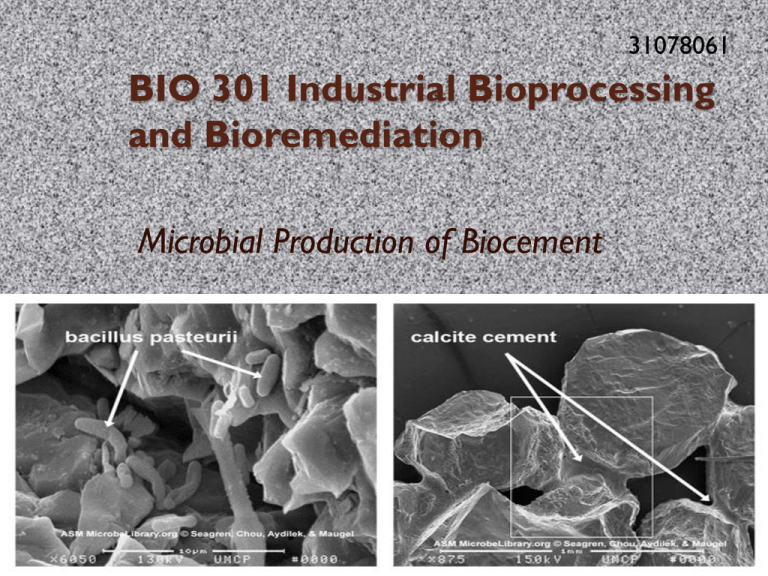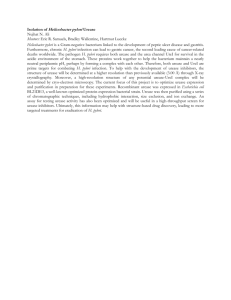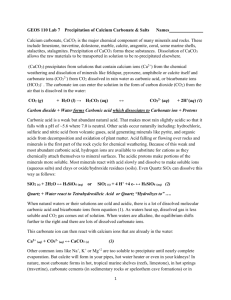02-31078061 Biocementation
advertisement

31078061 BIO 301 Industrial Bioprocessing and Bioremediation Microbial Production of Biocement Home Page Introduction Author profile Thesis 1 summary Thesis 2 summary Comparison between Thesis 1 and 2 Conclusion Reference Introduction Cementaion, precipitation of calcium carbonate, occurs in the process of microbial actions or naturally, forming natural rocks which are presence in the marine ,freshwater and soil environment. (Salwa.A.T,2008) Biocement, a solid crystaline form of calcium carbonate, could be obtained through the microbial urease activity occuring in the calcium-rich environment. (Whiffin,V. S. ,2004). Biocementation is defined as the sand consolidation technology in which the carbonate, released from the microbial hydrolysis of the urea, in the presence of excess calcium ions and from calcite(CaCO3)precipitate. (Salwa.A.T,2008) Author Profile Hello everyone , I am Frankie. I’m doing my third year studies here at Murdoch university , majoring in Biomedical science and Biotechnology. The reason I chose this topic was that I got inspired by the breakthrough of science in biocementaion which attracts the commercial values. Microbial CaCO3 precipitation for the production of Biocement This article focus on the biocementaion of the specific bacteria S. pasteurii and aim to produce biocement through a low-cost processes. (Whiffin,V. S. ,2004). The binding strength of the precipitated calcium carbonate can be increased by regulating the rate of carbonate formation by the bacteria. (Whiffin,V. S. ,2004). The enzyme urease produced by S. pasteurii is found to be functional in temperatures up to at least 80 ‘C , tolerating urea concentration up to 3M and calcium nitrate mixture up to 2 M. (Whiffin,V. S. ,2004). It is possible to reuse the urease activity which is one of the cost effective ways of producing biocement. (Whiffin,V. S. ,2004). Tests have been made to prove that this strain of bacteria is suitable for biocementation. For example, the ammonium concentration does not have a huge impact on urease activity. (Whiffin,V. S. ,2004). High strength in-situ Biocementation of soil by calcite precipitating locally isolated ureolytic bacteria Conditions that promote the urease activity of S. pasteurii was studied and can be found that this activity can be increased by increasing the concentration of yeast extract and nickel ions in the growth medium. (Salwa.A.T,2008) A term Biomineralisation was introduced and the growth and strength of the calcite crystal were studied, and it was found that the stregth is produced within the first 3 to 4 hours of the biocementation process. (Salwa.A.T,2008) The bacterial attachment to the intersurfaces such as sand granules ,has been studied and could be concluded that in 1m sand column, the bacterial attachment was stronger if they were grown in calcium ion rich medium. (Salwa.A.T,2008) It was recommended that biocementation process can be damaging to the environment because the ammonium produced from the hydrolysis of urea could be leaked to the groundwater and hence, the use of carbonsources in biocementation process may reduce this impact to the environment. (Salwa.A.T,2008) Comparison between Thesis 1 and 2 Thesis 1 focus more on the industrial point of view, finding a way to make the biocementation as cheap and practical as possible. In thesis 2, a more detailed study has been made on parameters affecting the in-situ biocementaion process. Both thesis were concerned about the ammonium impact on the environment. Conclusion Urease activity is an important part of the biocementation process and could be increased by concentrating the yeast extract and nickel ions in growth medium. The strength of the calcite were produced in the first 3 to 4 hours of biocemtation process and could be increased by regulating carbonate formation rate. The reuse of urease enzyme could be very costsaving to the industrialized biocemation. The waste management of the ammonium is required since it is harmful to the environment. Reference Al-Thawadi, Salwa (2008) High strength insitu biocementation of soil by calcite precipitating locally isolated ureolytic bacteria. PhD thesis, Murdoch University Whiffin,Victoria S. (2004) Microbial CaCO3 precipitation for the production of biocement. PhD thesis, Murdoch University.











